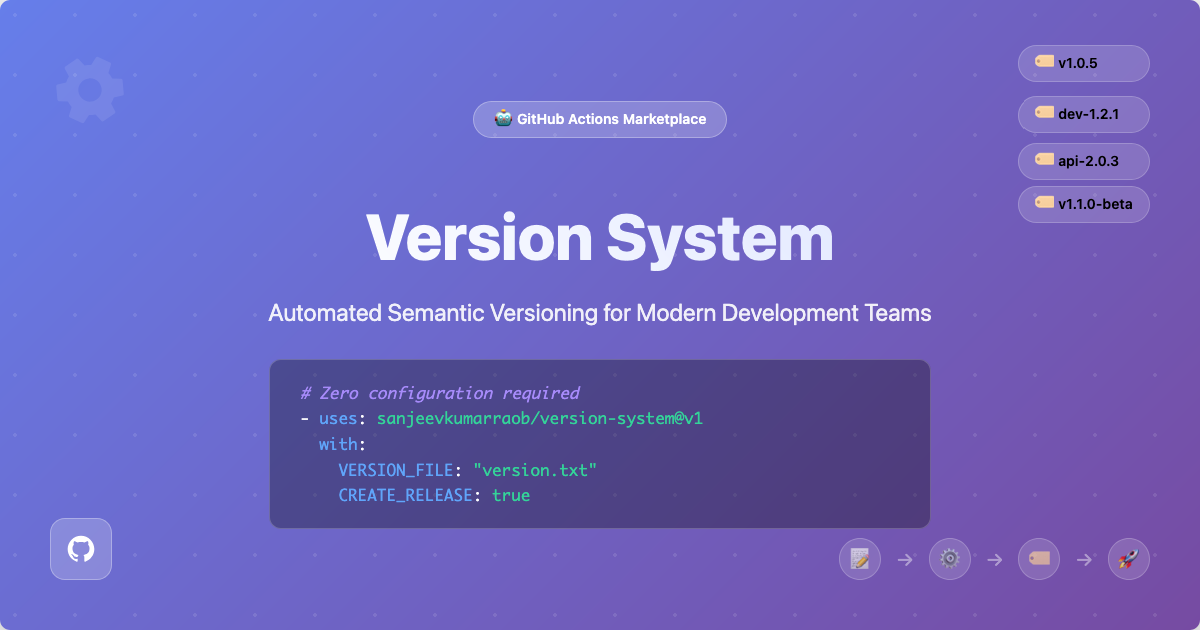How I solved a common developer pain point and built a tool that's now helping teams automate their release workflows

The Problem That Started It All
Picture this: It's Friday afternoon, you're ready to deploy your latest feature, but first you need to create a new version tag. You check the latest tag (v1.2.3), calculate the next version (v1.2.4), create the tag, push it, then manually create a GitHub release. Five minutes later, you realize you forgot to update the version in three different places.
Sound familiar?
This scenario played out repeatedly in my development workflow. What should have been a simple task became a source of friction and potential errors. Re-running multiple CI/CD jobs because of random manually pushed git tags was a nightmare. Creating tags for Docker images and pushing them to different ECR accounts across environments became an operational headache. Some projects needed prefixes like dev-1.0.0, others required module-specific tags like api-gateway-1.2.3 for monorepos, and each had different Docker tagging strategies.
That's when I decided to build Version System - a GitHub Action that handles all the complexity of semantic versioning automatically.
Why Another Versioning Tool?
Before diving into development, I evaluated existing solutions. While there were several versioning actions available, each had limitations:
Complex configuration: Required extensive YAML setup for basic functionality
Limited flexibility: Couldn't handle prefixes, suffixes, or module-specific versioning
Monorepo gaps: Poor support for independent module versioning
Manual release steps: Required additional actions for GitHub release creation
I wanted something that would:
Work with zero configuration for simple cases
Scale gracefully for complex scenarios
Handle monorepos elegantly
Automate the entire release process
Building Version System: Key Design Decisions
1. Zero Configuration by Default
The action should work immediately with minimal setup:
yaml- uses: sanjeevkumarraob/version-system@v1
with:
VERSION_FILE: "version.txt"Just point it to a version file containing your base version (like 1.0.0), and it automatically calculates the next patch version based on existing tags.
2. Flexible Architecture for Complex Scenarios
While simple by default, the action needed to handle complex real-world scenarios:
Prefixed versions for environments:
yaml- uses: sanjeevkumarraob/version-system@v1
with:
PREFIX: 'dev-'
VERSION_FILE: "version.txt"
# Outputs: dev-1.0.1, dev-1.0.2, etc.Module-specific versioning for monorepos:
yaml- uses: sanjeevkumarraob/version-system@v1
with:
MODULE: 'api-gateway'
VERSION_FILE: "services/api-gateway/version.txt"
# Outputs: api-gateway-1.0.1, api-gateway-1.0.2, etc.Suffix support for pre-releases:
yaml- uses: sanjeevkumarraob/version-system@v1
with:
SUFFIX: 'beta'
VERSION_FILE: "version.txt"
# Outputs: 1.0.1-beta, 1.0.2-beta, etc.3. Intelligent Tag Analysis
The core algorithm analyzes existing repository tags to:
Find the latest relevant version based on prefix/suffix/module filters
Parse semantic version components (major.minor.patch)
Calculate the appropriate next version
Handle edge cases like missing tags or malformed versions
4. Integrated Release Creation
Rather than requiring separate actions, Version System optionally creates both tags and GitHub releases:
yaml- uses: sanjeevkumarraob/version-system@v1
with:
VERSION_FILE: "version.txt"
CREATE_RELEASE: true # Creates tag + GitHub release with auto-generated notesTechnical Implementation Highlights
Python-Based Core Logic
I chose Python for the core versioning logic due to its excellent string processing capabilities and robust testing ecosystem. The main components:
Version Parser: Handles semantic version parsing with regex validation
Tag Manager: Interfaces with Git to fetch and analyze repository tags
Version Calculator: Implements the core logic for determining next versions
Security Module: Validates inputs and prevents path traversal attacks
Comprehensive Testing Strategy
With 97% test coverage, the action includes:
Unit tests: Individual component testing
Integration tests: End-to-end workflow validation
Edge case testing: Malformed versions, missing files, invalid inputs
Security testing: Input validation and sanitization
Shell Script Integration
The Python core integrates with a bash script that handles:
Environment variable processing
GitHub Actions output formatting
Error handling and logging
Real-World Impact and Use Cases
Since publishing to the GitHub Actions Marketplace, Version System has found adoption across various scenarios:
Enterprise Monorepos
Teams managing multiple services appreciate independent module versioning:
yaml# Different services, different versions
api-gateway-2.1.4
user-service-1.3.2
payment-service-3.0.1Environment-Specific Deployments
Development teams use prefixes for environment isolation:
yaml# Parallel versioning streams
prod-1.0.5
staging-1.0.8
dev-1.1.2Open Source Projects
Maintainers automate their release processes:
yaml# Automatic releases with generated notes
- name: Create Release
uses: sanjeevkumarraob/version-system@v1
with:
VERSION_FILE: "version.txt"
CREATE_RELEASE: trueLessons Learned
1. Start Simple, Scale Gradually
The zero-configuration approach attracted initial users, while advanced features retained them as needs grew complex.
2. Documentation is Critical
GitHub Actions require clear, example-driven documentation. The README became as important as the code itself.
3. Test Coverage Builds Trust
High test coverage wasn't just good practice - it became a selling point for teams evaluating the action for production use.
4. Community Feedback Drives Features
Several features (like suffix support and security validations) came from user requests and issue reports.
Try It Yourself
Ready to automate your versioning workflow? Get started in minutes:
Create a version file:
# version.txt 1.0.0Add to your GitHub workflow:
yaml- name: Generate Version uses: sanjeevkumarraob/version-system@v1 with: VERSION_FILE: "version.txt" CREATE_RELEASE: truePush and watch it work!
Resources
GitHub Marketplace: Version System Action
Source Code: GitHub Repository
Documentation: Complete usage examples and API reference
Building Version System taught me that the best tools solve real problems simply and scale gracefully. Sometimes the most impactful projects come from automating the small, repetitive tasks that slow us down every day.